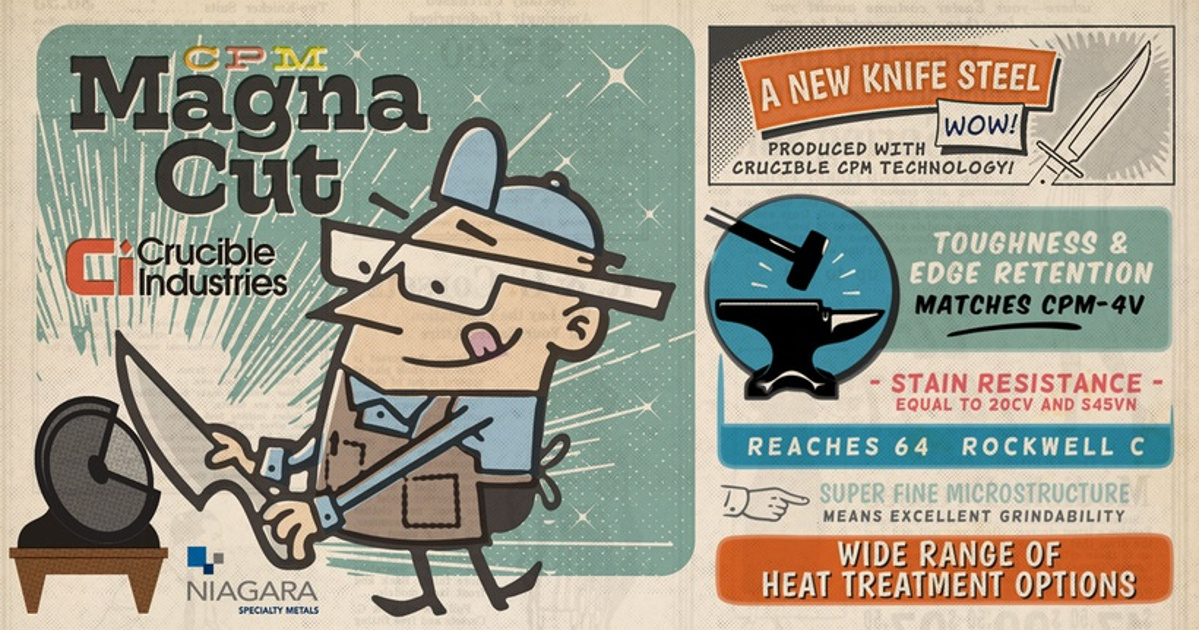badmatt
DON'T DO IT!
- Joined
- Mar 9, 2021
- Messages
- 3,186
Dont ask people what they think of Rex121... ask Rex121 what it thinks of people."Doctor, I'm cured, I'll need a prescription to buy more knives to make sure they don't talk to me anymore"

The BladeForums.com 2024 Traditional Knife is ready to order! See this thread for details:
https://www.bladeforums.com/threads/bladeforums-2024-traditional-knife.2003187/
Price is $300 $250 ea (shipped within CONUS). If you live outside the US, I will contact you after your order for extra shipping charges.
Order here: https://www.bladeforums.com/help/2024-traditional/ - Order as many as you like, we have plenty.
Dont ask people what they think of Rex121... ask Rex121 what it thinks of people."Doctor, I'm cured, I'll need a prescription to buy more knives to make sure they don't talk to me anymore"

It’s ok. I like Cruwear and 3V better.
So you're comparing Magnacut at 13 and 14 dps to Vanax at 15 dps, so it would make sense that that Magnacut would come out on top. Presumably that's on the theory that Vanax at 60-61 hrc wouldn't hold up at sub-15 dps edge angles. But I wonder if that would actually prove out on a Catra test? I wouldn't expect it to hold up AS well as the 64 hrc Magnacut, but I would expect it to perform better than 15 dps Vanax.Well, MagnaCut will be able to take advantage of higher strength at the edge to support lower angles with better resistance to deformation. Vanax will have a higher total carbonitride volume however the hardness HRC is limited. Vanax will have a higher volume of softer phase retained austenite in the matrix even with cryogenic processing which is detrimental to edge strength and apexing.
Lower edge angles in general will cut longer at a trade off with raw durability.
MagnaCut has fine carbonitrides at a lower volume and good toughness and working hardness range.
All of those features can be more advantageous for lower edge angles.
We can model this by graphing data from the Predicative CATRA formula below.
TCC (mm) = -157 + 15.8*Hardness (Rc) – 17.8*EdgeAngle(°) + 5.0*Fe3C(%) + 11.2*CrC(%) + 14.6*CrVC(%) + 26.2*MC(%) + 9.5*M6C(%) + 20.9*MN(%) + 19.4*CrN(%) [1]

Figure 1. Same edge angle 15°dps

Figure 2. MagnaCut with a 14° dps edge angle(-1°dps lower than on Vanax)

Figure 3. MagnaCut with a 13°dps edge vs a 15°dps edge on Vanax.
As Roman Landes has said "geometry cuts"
[1]https://knifesteelnerds.com/2018/11/19/steel-edge-retention/
You might have missed it, butSo you're comparing Magnacut at 13 and 14 dps to Vanax at 15 dps, so it would make sense that that Magnacut would come out on top.
Presumably that's on the theory that Vanax at 60-61 hrc wouldn't hold up at sub-15 dps edge angles. But I wonder if that would actually prove out on a Catra test? I wouldn't expect it to hold up AS well as the 64 hrc Magnacut, but I would expect it to perform better than 15 dps Vanax.

This is an issue that I have become aware of recently. Your graphs indicate that, going from 65 to 61 HRC, Magnacut suffers a 10% decrease in cutting longevity. So what’s the big harm in turning out a Magnacut knife at 61 or M390 at 60? I mean who is really going to miss that extra 10% of cutting endurance? How long does it take you to dull a knife, unless you’re cutting shingles?Well, MagnaCut will be able to take advantage of higher strength at the edge to support lower angles with better resistance to deformation. Vanax will have a higher total carbonitride volume however the hardness HRC is limited. Vanax will have a higher volume of softer phase retained austenite in the matrix even with cryogenic processing which is detrimental to edge strength and apexing.
Lower edge angles in general will cut longer at a trade off with raw durability.
MagnaCut has fine carbonitrides at a lower volume and good toughness and working hardness range.
All of those features can be more advantageous for lower edge angles.
We can model this by graphing data from the Predicative CATRA formula below.
TCC (mm) = -157 + 15.8*Hardness (Rc) – 17.8*EdgeAngle(°) + 5.0*Fe3C(%) + 11.2*CrC(%) + 14.6*CrVC(%) + 26.2*MC(%) + 9.5*M6C(%) + 20.9*MN(%) + 19.4*CrN(%) [1]

Figure 1. Same edge angle 15°dps

Figure 2. MagnaCut with a 14° dps edge angle(-1°dps lower than on Vanax)

Figure 3. MagnaCut with a 13°dps edge vs a 15°dps edge on Vanax.
As Roman Landes has said "geometry cuts"
[1]https://knifesteelnerds.com/2018/11/19/steel-edge-retention/
This is an issue that I have become aware of recently. Your graphs indicate that, going from 65 to 61 HRC, Magnacut suffers a 10% decrease in cutting longevity. So what’s the big harm in turning out a Magnacut knife at 61 or M390 at 60? I mean who is really going to miss that extra 10% of cutting power? How long does it take you to dull a knife, unless you’re cutting shingles?
The idea that MC at 64 Rc can be run thinner and thereby cut longer is true only for abrasive wear tests.
It's a trendy hair salon.What is magnacut? Is it a new knife manufacturer?
A gym, I think.It's a trendy hair salon.
It's a brilliant new steel from Larrin.What is magnacut? Is it a new knife manufacturer?

“Surgical stainless”A gym, I think.
I'm using Ozempic instead.
The needle is made of a special steel, I've heard.
